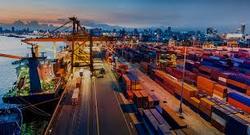Cargo volumes at major ports up 7.2% in first half 2018

The Shanghai International Shipping Institute’s (SISI) most recent second quarter Global Port Development Report showed the effect of some the current trade and economic issues on the global sea freight market.
As a result of the continued global economic recovery, SISI said global port throughput continued to rise in the second quarter, with the cargo throughput of major ports rising by 7.23% while container throughput increased by 3.25%.
Among terminal operators, the top five players comprising all Chinese ports apart from second placed Singapore, saw equity container throughput of 40.9m teu and grew 6.8% in the second quarter.
The period was also saw the tangible effects of trade and economic policies starting to kick in. Key among these were the effects on throughput at some US and China ports and the strong growth in dry bulk throughput at Australian ports as well as the growth in liquid bulk throughput in general.
The Sino-US trade war affected cargo volumes with US ports seemingly coming off worse off in the conflict. The Port of South Louisiana suffered the most serious impact, with cargo throughput falling by 7.2%, SISI noted.
This was due to the fact that major taxable products involved in the trade war were mainly exports out of the US and experienced declines in throughput to different degrees. For example, chemicals, soybeans and steel fell by 4%, 3% and a whopping 10% respectively. In contrast most of the Chinese exports hit by the US tariffs are technology and capital-intensive products, which are not usually freighted by sea. Set against China’s large cargo volume base the impact on total throughput at Chinese ports is expected to be muted, SISI said.
Meanwhile Australian ports enjoyed strong growth in dry bulk throughput as the recovery of the global economy saw iron ore exports benefit from the increasing demand for infrastructure construction in multiple markets.
The Port of Hedland saw iron ore throughput rise 4.2% to 135m tons in the second quarter. In terms of coal exports, Australian ports recovered from the low base caused by bad weather at Hay Point Port in the second quarter of 2017 to see throughput of 28.5m tons.
The other key trend was the general rise in liquid bulk throughput at ports around the world due to the rise in international oil prices in the second quarter and the current high price levels. With the oversupply situation easing and the sharp drop in inventories, SISI note that the global crude oil market experienced booms in both supply and demand.
Most of the global major liquid bulk terminals achieved high growth rates in oil throughput and in particular, the South Korean ports of Gwangyang, Daesan and Incheon oil throughput growth exceeding 20%, SISI said.
Global container terminal operators also saw sustained growth in throughput. Among these, Cosco Shipping Ports benefited from increased calls from Ocean Alliance members and the group’s new terminal assets, with equity container throughput increasing by 13.8% in the second quarter.
China Merchants Port meanwhile continued its aggressive overseas port expansion, and saw its single-quarter equity container throughput crossing over the 10m teu mark. DP World however saw its equity container throughput shrink 1.5% as it missed the incremental gains from its increased stake in Busan Port and shifted its development strategy.
Tighter environmental policy also led to declines in throughput at some ports. In particular Port of Rotterdam saw a steep 11.9% drop in coal throughput as coal-fired power plants were shut down. Likewise in Tianjin Port, a ban on coal transport by automobiles, led to cargo throughput declining by 4.8% in the second quarter.
However a standout performer was Yantai Port, which led the growth of global cargo ports with a growth rate of 54.2% in the first half of the year and became China’s top bauxite importing port with cumulative bauxite throughput of 55m tons.